sensor TOYOTA GR86 2022 (in English) Owner's Manual
[x] Cancel search | Manufacturer: TOYOTA, Model Year: 2022, Model line: GR86, Model: TOYOTA GR86 2022Pages: 582, PDF Size: 86.38 MB
Page 237 of 582
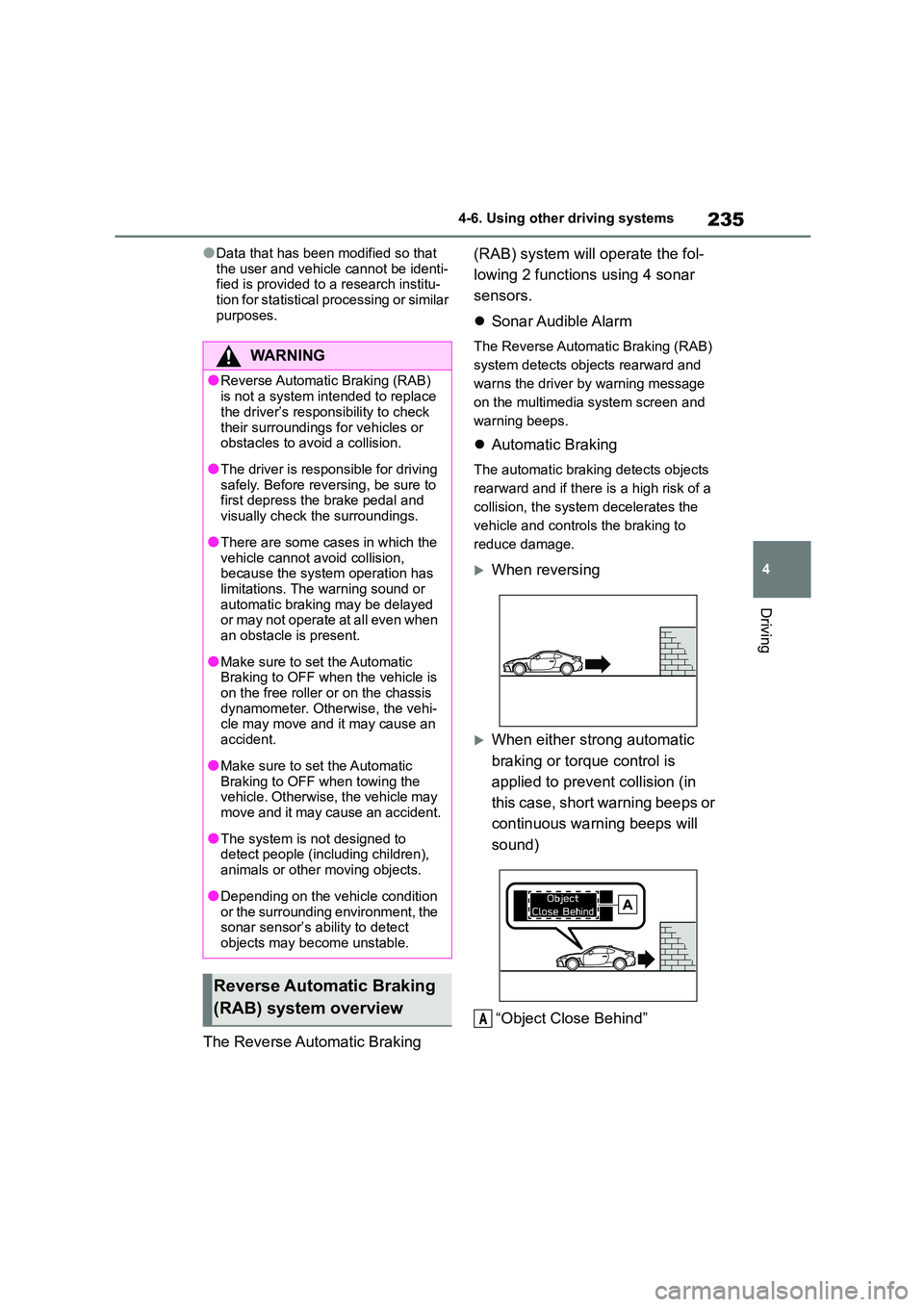
235
4
4-6. Using other driving systems
Driving
●Data that has been modified so that
the user and vehicle cannot be identi- fied is provided to a research institu-
tion for statistical processing or similar
purposes.
The Reverse Automatic Braking
(RAB) system will operate the fol-
lowing 2 functions using 4 sonar
sensors.
Sonar Audible Alarm
The Reverse Automatic Braking (RAB)
system detects objec ts rearward and
warns the driver by warning message
on the multimedia system screen and
warning beeps.
Automatic Braking
The automatic braking detects objects
rearward and if there is a high risk of a
collision, the system decelerates the
vehicle and controls the braking to
reduce damage.
When reversing
When either strong automatic
braking or torque control is
applied to prevent collision (in
this case, short warning beeps or
continuous warning beeps will
sound)
“Object Close Behind”
WA R N I N G
●Reverse Automatic Braking (RAB)
is not a system intended to replace
the driver’s responsibility to check
their surroundings for vehicles or obstacles to avoid a collision.
●The driver is responsible for driving safely. Before revers ing, be sure to
first depress the brake pedal and
visually check the surroundings.
●There are some cases in which the
vehicle cannot avoid collision, because the system operation has
limitations. The warning sound or
automatic braking may be delayed or may not operate at all even when
an obstacle is present.
●Make sure to set the Automatic
Braking to OFF when the vehicle is
on the free roller or on the chassis dynamometer. Otherwise, the vehi-
cle may move and it may cause an
accident.
●Make sure to set the Automatic
Braking to OFF when towing the vehicle. Otherwise, the vehicle may
move and it may cause an accident.
●The system is not designed to
detect people (including children),
animals or other moving objects.
●Depending on the vehicle condition
or the surrounding environment, the sonar sensor’s ability to detect
objects may become unstable.
Reverse Automatic Braking
(RAB) system overviewA
Page 239 of 582

237
4
4-6. Using other driving systems
Driving
have the system inspected.
• A sticker, paint, or a chemical is applied to the sonar sensors or the
rear bumper near the sonar sensor.
• The rear bumper is modified. • The rear bumper has been removed
and attached.
• The ground clearance is changed due to the vehicle’s loading condition or
modification.
• There is damage to the sonar sensors or the rear bumper near the sonar
sensor.
• The rear bumper is exposed to strong impact, or the rear bumper is
deformed.
●On a steep hill, the system’s auto-
matic braking ability will be reduced.
●The system is designed to avoid colli-
sions by automatic hard braking when
the vehicle’s reversing speed is less than approximately 5 km/h (3 mph).
However, the system does not guar-
antee that the vehicle will be able to avoid collisions in any situation.
●If the vehicle is reversed at an extremely slow speed, the driver’s
operation may be prioritized. In this
case, automatic braking will not oper- ate.
●The system may not be able to detect and apply the brake with the following
objects.
• Sharp or thin objects such as poles, fences and ropes which may not
reflect the sound wave emitted from
the sonar sensor. • Objects that are too close to the rear
bumper when the shift lever is set to
R. • Objects with a surface which may not
reflect the sound wave emitted from
the sonar sensor such as a chain link
fence.
●Objects the system is not designed to
detect and apply brake. • Pedestrians.
• Moving objects including moving vehi-
cles. • Objects which absorbs sound waves
such as cloth or snow.
• Objects whose surface has a diagonal
angle. • Objects that are low to the ground
such as parking blocks.
• Objects that are high above the ground such as objects hanging from
above.
• Objects that are out of range of the center of the vehicle in the horizontal
direction.
• Objects that are not in a vertical direc- tion.
• Objects which are not perpendicular
to the ground. • Objects which are not directly in the
traveling direction of the vehicle.
• Objects which are uneven or wavy.
●When reversing the vehicle, the func-
tions may not be able to work properly or may cause a system malfunction if
the following conditions exist.
High frequency sound from other
sources are nearby:
• Horn sound from another vehicle. • Engine sound from other vehicles.
• Sound of an air brake.
• Vehicle detection equipment or a sonar from another vehicle.
• A sound wave with a frequency similar
to the vehicle’s system is transmitted near by.
• A vehicle equipped with the same sys-
tem is reversing toward your reversing direction.
●Weather conditions:• Extremely high or extremely low tem-
peratures in which the area near the
sonar sensor becomes too hot or too cold to operate.
• The sonar sensors or the rear bumper
near the sonar sensors are exposed to heavy rain or a significant amount
of water.
• Fog, snow or sandstorm, etc.
• Air is moving rapidly such as when a strong wind is blowing.
●Parts attached to the rear bumper near the sonar sensor:
• Commercial electronic parts (fog light,
fender pole, radio antenna) or com- mercial attachment parts (trailer hitch,
Page 240 of 582
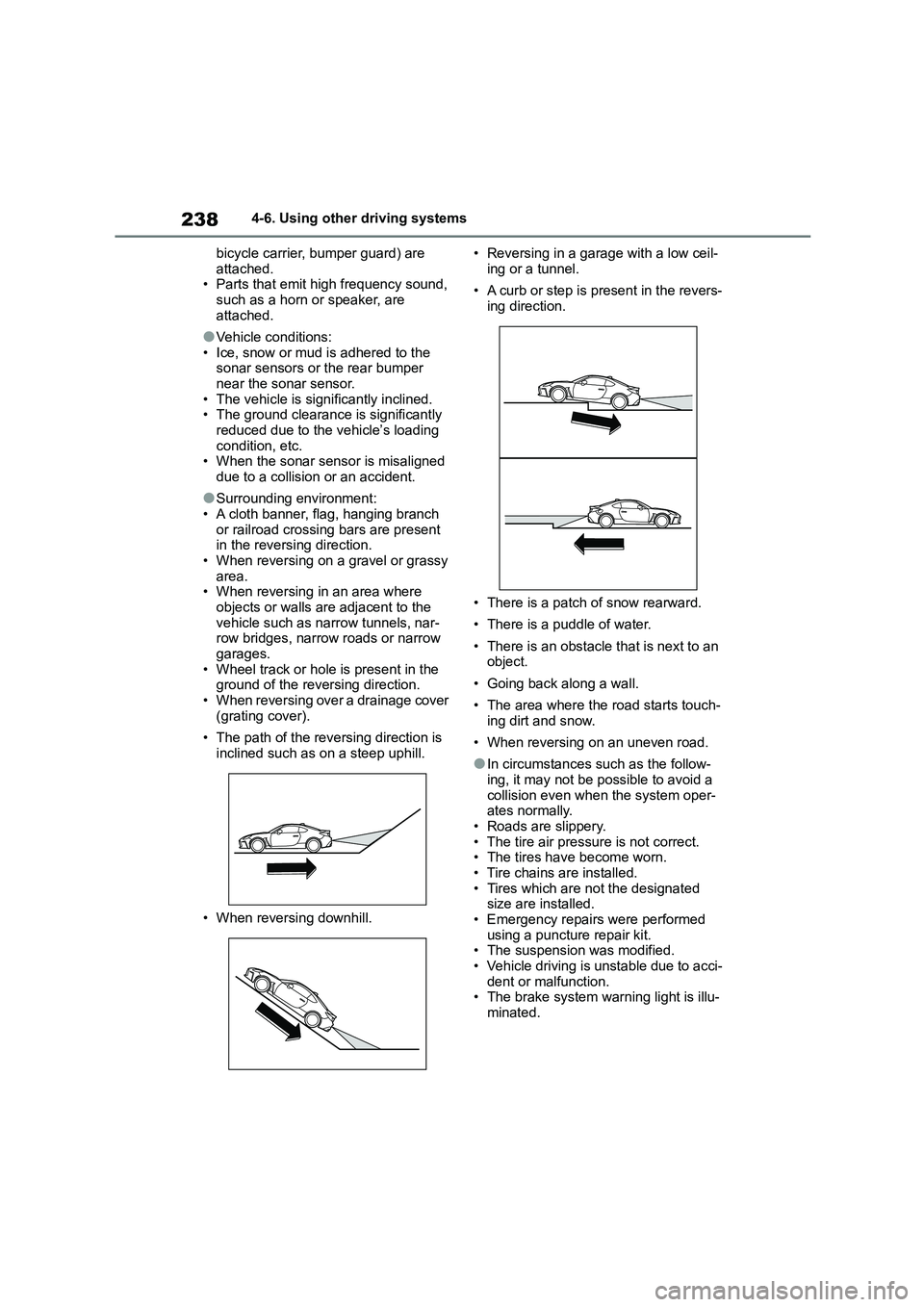
2384-6. Using other driving systems
bicycle carrier, bumper guard) are
attached. • Parts that emit high frequency sound,
such as a horn or speaker, are
attached.
●Vehicle conditions:
• Ice, snow or mud is adhered to the sonar sensors or the rear bumper
near the sonar sensor.
• The vehicle is significantly inclined. • The ground clearance is significantly
reduced due to the vehicle’s loading
condition, etc. • When the sonar sensor is misaligned
due to a collision or an accident.
●Surrounding environment:
• A cloth banner, flag, hanging branch
or railroad crossing bars are present in the reversing direction.
• When reversing on a gravel or grassy
area. • When reversing in an area where
objects or walls are adjacent to the
vehicle such as narrow tunnels, nar- row bridges, narrow roads or narrow
garages.
• Wheel track or hole is present in the ground of the reversing direction.
• When reversing over a drainage cover
(grating cover).
• The path of the reversing direction is
inclined such as on a steep uphill.
• When reversing downhill.
• Reversing in a garage with a low ceil-
ing or a tunnel.
• A curb or step is present in the revers-
ing direction.
• There is a patch of snow rearward.
• There is a puddle of water.
• There is an obstacle that is next to an
object.
• Going back along a wall.
• The area where the road starts touch-
ing dirt and snow.
• When reversing on an uneven road.
●In circumstances su ch as the follow- ing, it may not be possible to avoid a
collision even when the system oper-
ates normally. • Roads are slippery.
• The tire air pressure is not correct.
• The tires have become worn. • Tire chains are installed.
• Tires which are not the designated
size are installed. • Emergency repairs were performed
using a puncture repair kit.
• The suspension was modified. • Vehicle driving is unstable due to acci-
dent or malfunction.
• The brake system warn ing light is illu-
minated.
Page 243 of 582
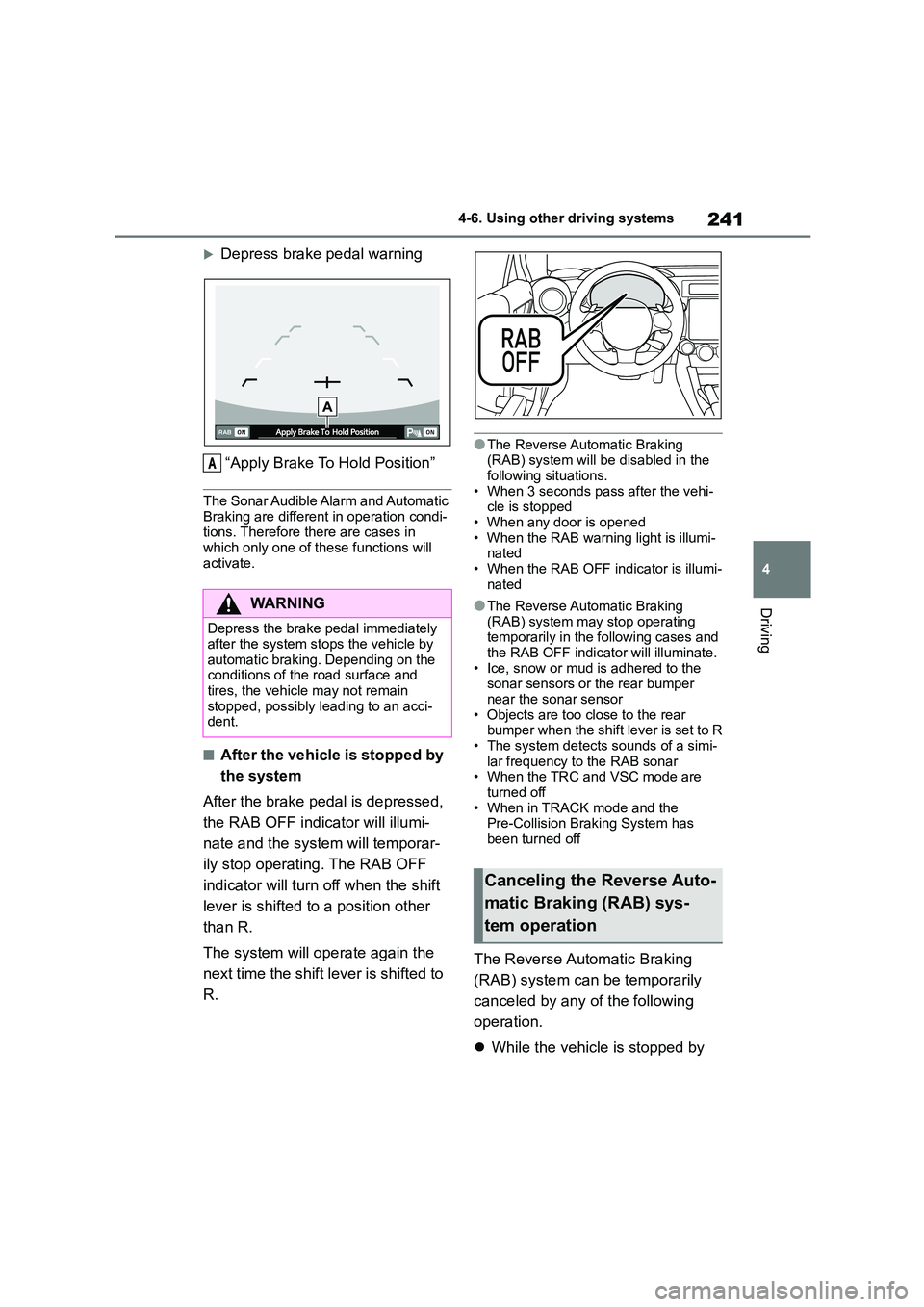
241
4
4-6. Using other driving systems
Driving
Depress brake pedal warning
“Apply Brake To Hold Position”
The Sonar Audible Alarm and Automatic
Braking are different in operation condi-
tions. Therefore there are cases in which only one of these functions will
activate.
■After the vehicle is stopped by
the system
After the brake pedal is depressed,
the RAB OFF indicator will illumi-
nate and the syst em will temporar-
ily stop operating. The RAB OFF
indicator will turn off when the shift
lever is shifted to a position other
than R.
The system will operate again the
next time the shift le ver is shifted to
R.
●The Reverse Automatic Braking (RAB) system will be disabled in the
following situations.
• When 3 seconds pass after the vehi- cle is stopped
• When any door is opened
• When the RAB warning light is illumi- nated
• When the RAB OFF indicator is illumi-
nated
●The Reverse Automatic Braking
(RAB) system may stop operating temporarily in the following cases and
the RAB OFF indicator will illuminate.
• Ice, snow or mud is adhered to the sonar sensors or the rear bumper
near the sonar sensor
• Objects are too close to the rear bumper when the shift lever is set to R
• The system detects sounds of a simi-
lar frequency to the RAB sonar • When the TRC and VSC mode are
turned off
• When in TRACK mode and the Pre-Collision Braking System has
been turned off
The Reverse Automatic Braking
(RAB) system can be temporarily
canceled by any of the following
operation.
While the vehicle is stopped by
WA R N I N G
Depress the brake pedal immediately after the system stops the vehicle by
automatic braking. Depending on the
conditions of the road surface and
tires, the vehicle may not remain stopped, possibly leading to an acci-
dent.
A
Canceling the Reverse Auto-
matic Braking (RAB) sys-
tem operation
Page 245 of 582
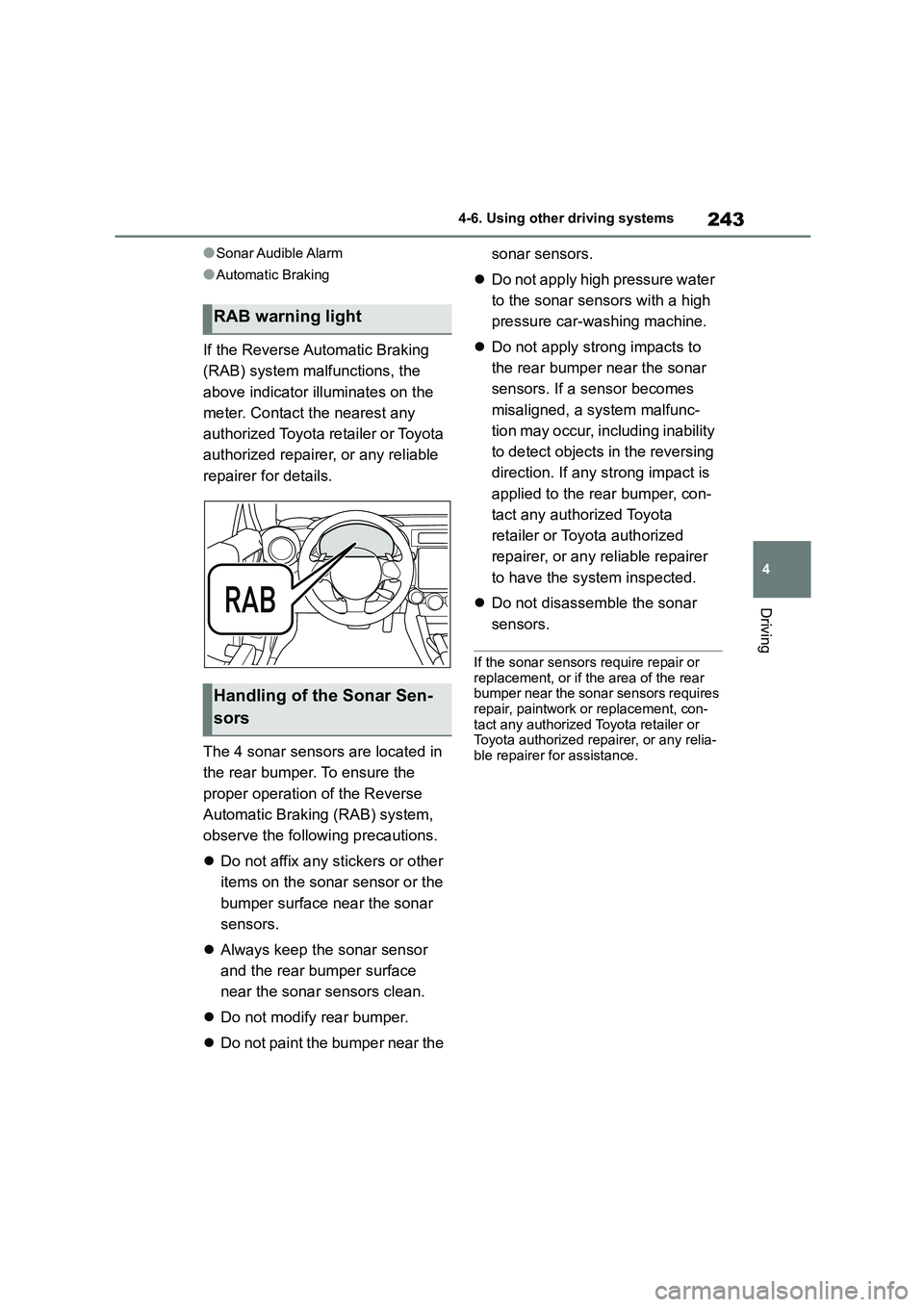
243
4
4-6. Using other driving systems
Driving
●Sonar Audible Alarm
●Automatic Braking
If the Reverse Automatic Braking
(RAB) system malfunctions, the
above indicator illuminates on the
meter. Contact the nearest any
authorized Toyota retailer or Toyota
authorized repairer, or any reliable
repairer for details.
The 4 sonar sensors are located in
the rear bumper. To ensure the
proper operation of the Reverse
Automatic Braking (RAB) system,
observe the following precautions.
Do not affix any stickers or other
items on the sonar sensor or the
bumper surface near the sonar
sensors.
Always keep the sonar sensor
and the rear bumper surface
near the sonar sensors clean.
Do not modify rear bumper.
Do not paint the bumper near the
sonar sensors.
Do not apply high pressure water
to the sonar sensors with a high
pressure car-wa shing machine.
Do not apply strong impacts to
the rear bumper near the sonar
sensors. If a sensor becomes
misaligned, a system malfunc-
tion may occur, including inability
to detect objects in the reversing
direction. If any strong impact is
applied to the rear bumper, con-
tact any authorized Toyota
retailer or Toyota authorized
repairer, or any reliable repairer
to have the system inspected.
Do not disassemble the sonar
sensors.
If the sonar sensors require repair or replacement, or if the area of the rear
bumper near the sonar sensors requires
repair, paintwork or replacement, con- tact any authorized Toyota retailer or
Toyota authorized repairer, or any relia-
ble repairer for assistance.
RAB warning light
Handling of the Sonar Sen-
sors
Page 309 of 582
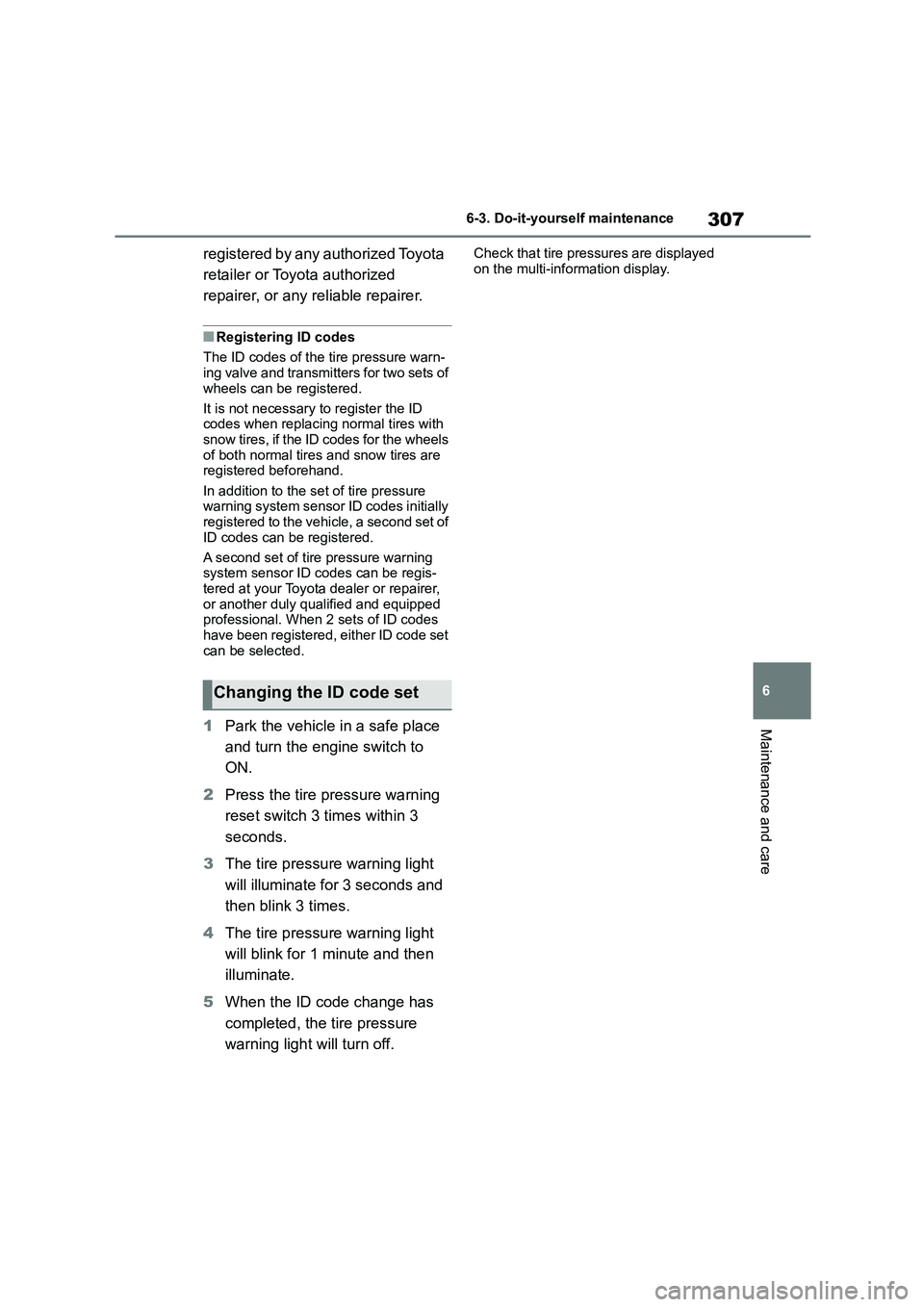
307
6
6-3. Do-it-yourself maintenance
Maintenance and care
registered by any authorized Toyota
retailer or Toyota authorized
repairer, or any reliable repairer.
■Registering ID codes
The ID codes of the tire pressure warn- ing valve and transmitters for two sets of
wheels can be registered.
It is not necessary to register the ID codes when replacing normal tires with
snow tires, if the ID codes for the wheels
of both normal tires and snow tires are registered beforehand.
In addition to the set of tire pressure
warning system sensor ID codes initially registered to the vehicle, a second set of
ID codes can be registered.
A second set of tire pressure warning system sensor ID codes can be regis-
tered at your Toyota dealer or repairer,
or another duly qualified and equipped professional. When 2 sets of ID codes
have been registered, either ID code set
can be selected.
1 Park the vehicle in a safe place
and turn the engine switch to
ON.
2 Press the tire pressure warning
reset switch 3 times within 3
seconds.
3 The tire pressure warning light
will illuminate for 3 seconds and
then blink 3 times.
4 The tire pressure warning light
will blink for 1 minute and then
illuminate.
5 When the ID code change has
completed, the tire pressure
warning light will turn off.
Check that tire pressures are displayed
on the multi-information display.
Changing the ID code set
Page 344 of 582
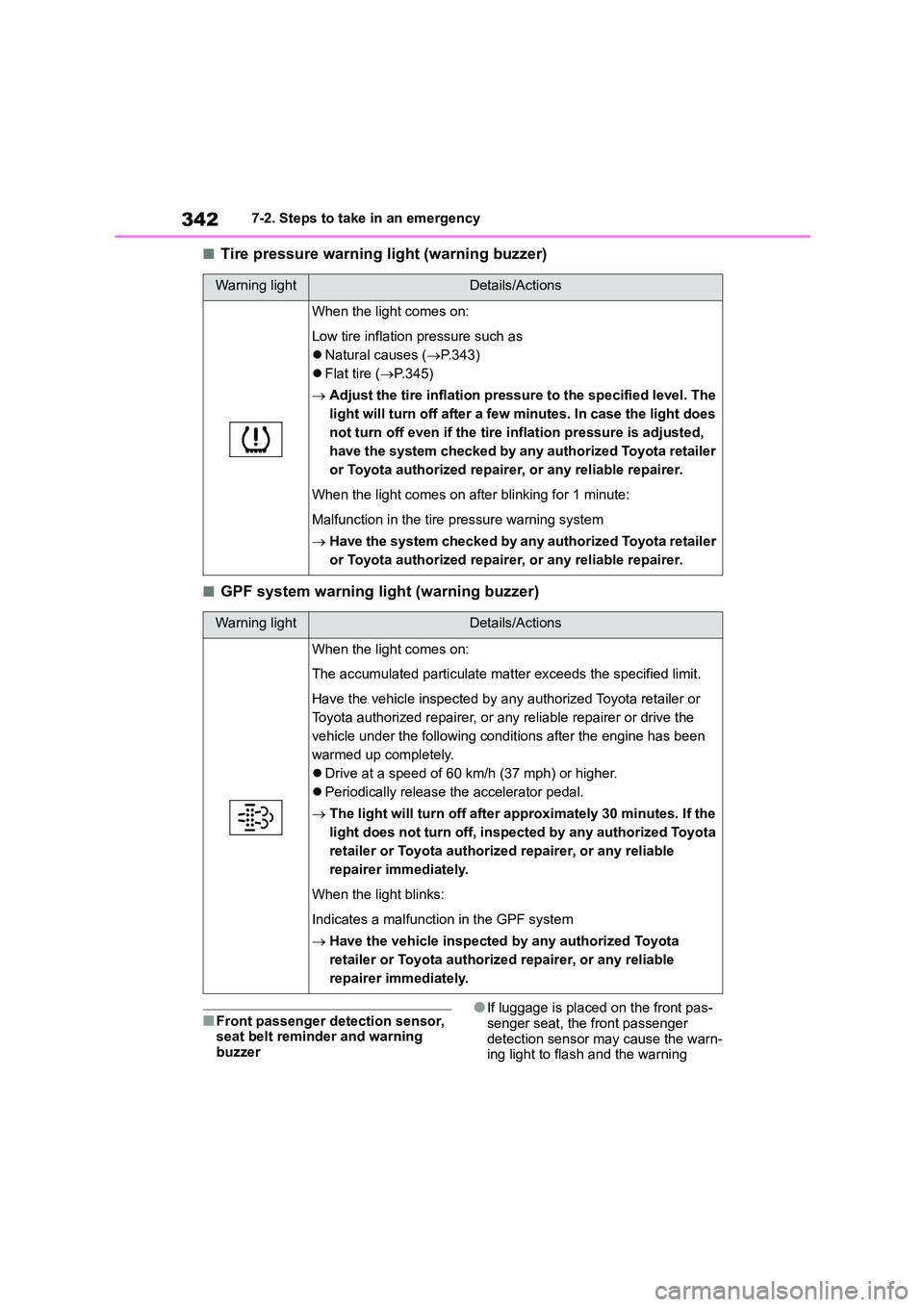
3427-2. Steps to take in an emergency
■Tire pressure warning light (warning buzzer)
■GPF system warning light (warning buzzer)
■Front passenger detection sensor,
seat belt reminder and warning buzzer
●If luggage is placed on the front pas-
senger seat, the front passenger
detection sensor may cause the warn- ing light to flash and the warning
Warning lightDetails/Actions
When the light comes on:
Low tire inflation pressure such as
Natural causes (P.343)
Flat tire (P.345)
Adjust the tire inflation pressure to the specified level. The
light will turn off after a few minutes. In case the light does
not turn off even if the tire inflation pressure is adjusted,
have the system checked by any authorized Toyota retailer
or Toyota authorized repairer, or any reliable repairer.
When the light comes on after blinking for 1 minute:
Malfunction in the tire pressure warning system
Have the system checked by any authorized Toyota retailer
or Toyota authorized repairer, or any reliable repairer.
Warning lightDetails/Actions
When the light comes on:
The accumulated particulate matter exceeds the specified limit.
Have the vehicle inspected by any authorized Toyota retailer or
Toyota authorized repairer, or any reliable repairer or drive the
vehicle under the following conditions after the engine has been
warmed up completely.
Drive at a speed of 60 km/h (37 mph) or higher.
Periodically release the accelerator pedal.
The light will turn off after approximately 30 minutes. If the
light does not turn off, inspected by any authorized Toyota
retailer or Toyota authorized repairer, or any reliable
repairer immediately.
When the light blinks:
Indicates a malfunction in the GPF system
Have the vehicle inspected by any authorized Toyota
retailer or Toyota authorized repairer, or any reliable
repairer immediately.
Page 345 of 582
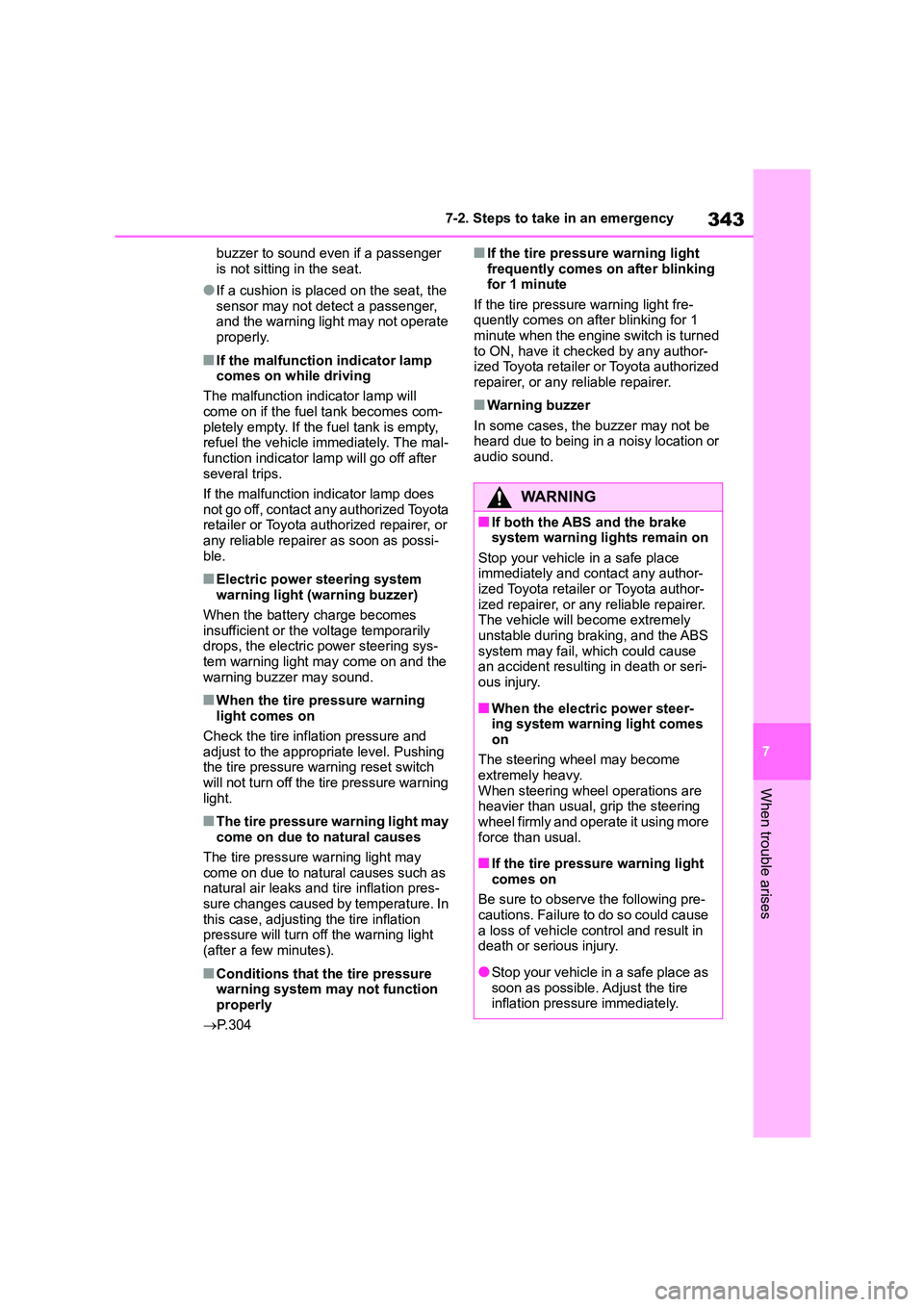
343
7
7-2. Steps to take in an emergency
When trouble arises
buzzer to sound even if a passenger
is not sitting in the seat.
●If a cushion is placed on the seat, the
sensor may not detect a passenger, and the warning light may not operate
properly.
■If the malfunction indicator lamp
comes on while driving
The malfunction indicator lamp will
come on if the fuel tank becomes com-
pletely empty. If the fuel tank is empty, refuel the vehicle immediately. The mal-
function indicator lamp will go off after
several trips.
If the malfunction indicator lamp does
not go off, contact any authorized Toyota
retailer or Toyota authorized repairer, or any reliable repairer as soon as possi-
ble.
■Electric power steering system
warning light (warning buzzer)
When the battery charge becomes
insufficient or the voltage temporarily
drops, the electric power steering sys- tem warning light may come on and the
warning buzzer may sound.
■When the tire pressure warning
light comes on
Check the tire inflation pressure and
adjust to the appropriate level. Pushing
the tire pressure wa rning reset switch will not turn off the tire pressure warning
light.
■The tire pressure warning light may
come on due to natural causes
The tire pressure warning light may
come on due to natural causes such as
natural air leaks and tire inflation pres- sure changes caused by temperature. In
this case, adjusting the tire inflation
pressure will turn off the warning light
(after a few minutes).
■Conditions that the tire pressure warning system may not function
properly
P.304
■If the tire pressure warning light
frequently comes on after blinking for 1 minute
If the tire pressure warning light fre-
quently comes on after blinking for 1 minute when the engine switch is turned
to ON, have it checked by any author-
ized Toyota retailer or Toyota authorized repairer, or any reliable repairer.
■Warning buzzer
In some cases, the buzzer may not be
heard due to being in a noisy location or audio sound.
WA R N I N G
■If both the ABS and the brake
system warning lights remain on
Stop your vehicle in a safe place immediately and contact any author-
ized Toyota retailer or Toyota author-
ized repairer, or any reliable repairer. The vehicle will become extremely
unstable during br aking, and the ABS
system may fail, which could cause an accident resulting in death or seri-
ous injury.
■When the electric power steer-
ing system warning light comes
on
The steering wheel may become
extremely heavy.
When steering wheel operations are heavier than usual, grip the steering
wheel firmly and operate it using more
force than usual.
■If the tire pressure warning light
comes on
Be sure to observe the following pre-
cautions. Failure to do so could cause
a loss of vehicle control and result in death or serious injury.
●Stop your vehicle in a safe place as soon as possible. Adjust the tire
inflation pressure immediately.
Page 382 of 582

3808-2. Customization
■Tr u nk (P.106)
■Power windows (P.126)
■Turn signal lever (P.150)
■ASC (Active Sound Control) (P.152)
■Automatic light control system (P.153)
FunctionDefault settingCustomized setting
Opening the trunk without
an electronic keyOnOff——O
ABC
FunctionDefault settingCustomized setting
Wireless remote control
linked operationOffOn——O
ABC
FunctionDefault settingCustomized setting
One-touch lane change
functionOnOffOOO
ABC
FunctionDefault settingCustomized setting
ASC (Active Sound Con-
trol)OnOff——O
ABC
FunctionDefault settingCustomized setting
Light sensor sensitivityMid
Min
——OLow
High
Max
Time that the welcome
lighting system operates
(when entering the vehicle)
30 seconds
60 seconds
——O90 seconds
120 seconds
Off
ABC
Page 389 of 582

387What to do if... (Troubleshooting)
Is the electronic key anywhere
detectable inside the vehicle?
( P.110)
Is the steering wheel unlocked?
( P.139)
Is the electronic key battery
weak or depleted?
In this case, the engine can be started
in a temporary way. ( P.358)
Is the battery discharged?
( P.359)
Is the engine switch in ON?
If you cannot release the shift lever by
depressing the brake pedal with the
engine switch in ON. ( P.144)
It is locked automatically to pre-
vent theft of the vehicle.
( P.139)
Is the window lock switch
pressed?
The power window except for the one
at the driver’s seat cannot be operated
if the window lock switch is pressed.
( P.127)
The auto power off function will
be operated if the vehicle is left
in ACC or ON (the engine is not
running) for a period of time.
( P.142)
The seat belt reminder light is
flashing
Are the driver and the passenger wear-
ing the seat belts? ( P.339)
The brake system warning light
is on
Is the parking brake released?
( P.151)
Depending on the situation, other
types of warning buzzer may also
sound. ( P.336, 344)
Did anyone inside the vehicle
open a door during setting the
alarm?
The sensor detects it and the alarm
sounds. ( P. 8 1 )
Do one of the following to deacti-
vate or stop the alarm:
Unlock the doors or open the
trunk using the entry function or
The shift lever cannot be
shifted from P even if you
depress the brake pedal
(Automatic transmission)
The steering wheel cannot
be turned after the engine is
stopped
The windows do not open or
close by operating the
power window switches
The engine switch is turned
off automatically
A warning buzzer sounds
during driving
An alarm is activated and the
horn sounds (if equipped)